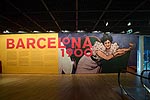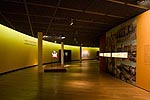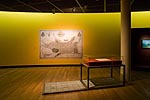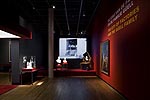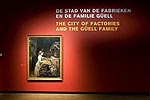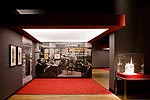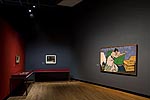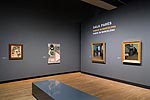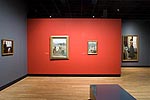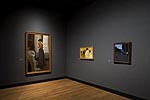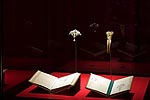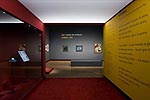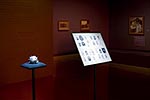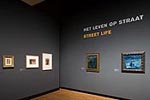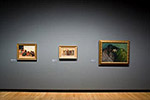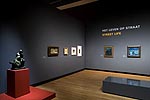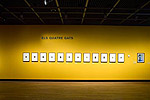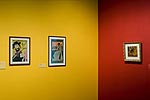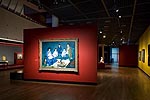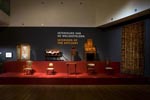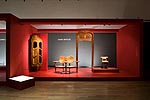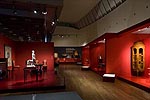The browser will either open the file, download it, or display a dialog.
|
Barcelona 1900 Catalogue: |
|||
|
Exhibitions dedicated to the history, culture and art of famous cities have been commonplace in recent years (including other exhibitions by the van Gogh Museum), although a temporary exhibition that examines a specific city with historical insight has rarely been realized. Thus, when the Van Gogh Museum recently held its Barcelona 1900 exhibition there was considerable reason for rejoicing since this show provided a visitor with a careful reconstruction of the issues and themes that were at work in the city 100 years ago, and which were reflected in the various types of art works that were created at that moment in time (fig. 1). |
|||
|
Barcelona 1900 conveyed the idea that the city hoped to become the Paris of the south, a haven for artists, and a cultural center that would demonstrate how modernity was changing Spain. Through paintings, drawings, prints, books, periodicals, architectural designs, wrought ironwork, jewelry, furniture, the reconstruction of sections of room interiors, photographs, documents, and films, a well rounded picture of Barcelona was evoked. The exhibition revealed how the themes used in the show were linked to the identity of the city and to the maintenance of long standing cultural traditions that were being modified. In following the schematic outline of the installation, it was possible for a visitor to gain a substantial understanding of the vital life of the city while also seeing how artwork reflected the new ideas of the era. This is the way in which we will examine this show. |
|||
|
The first thematic section presented the evolution of Barcelona by revealing patterns of growth. By 1860, the formerly walled city had experienced an intense increase in population coupled with considerable industrial expansion. In response, the city approved a comprehensive plan that became one of the largest urban redevelopment projects of the nineteenth century, whereby medieval, narrow streets were changed into carefully controlled spaces that did much to provide room for new townhouses and wide thoroughfares where people could walk together arm in arm. The World Exhibition of 1888 further spurred this development as the city became increasingly aware of, and open to, influences from foreign countries. In visualizing this part of the show, the organizers used maps, sculptures, photographs, a painting by Santiago Rusiñol of the Barcelona Harbor, and a period film clip that took one into the modernized harbor of the city. The visitor was introduced to the sites of the era and to changes that were actually underway. The panoramic city plans did much to demonstrate that Barcelona was looking forward to the future where modernity would be lastingly appreciated (figs. 2, 3). |
|||
|
The industrialization of Barcelona, under the aegis of the Guell family (and others), saw a growth in the textile industry. Guell, in turn, became a very passionate supporter of the visual arts, especially the architectural work of Antonio Gaudí. The contrast between the wealth of the Guell family, reinforced by the inclusion of a Gaudí dressing table from the Guell townhouse (fig. 4), with the position of young children in a textile factory was strikingly visualized in Joan Planella’s painting Working Girl, 1882 (fig. 5). Here the artist portrayed a young girl, a representative of the poor underclass in the city, as she strives to tame a machine too big and powerful for her size, thereby drawing attention to the plight of young children in factories, and to the fact that the future held no promise of a reprieve. This second section of the large exhibition contrasted two aspects of urban life—poverty and wealth—elements that were present in the city during this period of intense renovation. |
|||
|
This same era saw the development of the Modernist style when artists and writers were deeply influenced by outside stimuli. Artists established an avant-garde magazine, L’Avenç (Progress) by 1881 where critical articles over the ensuing years focused on the latest European developments in art, literature and science (fig. 6). This magazine, at an early moment, played a key role in formulating the modern style. In the third section of the exhibition, a photograph of the façade of the shop selling the magazine helps situate the contribution within its proper historical context. Pages from the magazine, combined with a poster by Ramon Casas promoting a wine, further revealed the influence of French graphic arts on artists in Catalonia. This section ably prepared the foundation for the aesthetic revolution that was beginning to emerge among Catalonian artists, some of whom had already been to France (fig. 7). |
|||
|
In the next section, dedicated to the Barcelona exhibition space Sala Peres, the show moved into very significant territory. By including the works Santiago Rusiñol and Ramon Casas completed in Paris, the show highlighted the ways in which Parisian locations and attitudes toward creativity were being directly transmitted to the younger painters of Barcelona. With images inspired by Montmartre, such as café scenes, advertisements for French cigarettes, or studies of the Moulin de la Galette, the Spanish artists appropriated the sites and people of France by creating a type of universal visual language that would also lead them back to using similar sites and themes derived from Barcelona. Recording what they saw, in a direct naturalist way, Spanish painters used scenes drawn from everyday life to construct their own vision of the Catalan city. When works by Ramon Pichot or Isidre Nonell were also shown at the Sala Pares, it suggested that the process of absorption was well underway (fig. 8). This section is one of the most successful areas in the Barcelona 1900 installation (figs. 9, 10). |
|||
|
Sharply contrasting with the world of bohemia was the life of those with upward mobility. The wealthy middle class frequented the fashionable Barcelona opera house dressed in elegant gowns and extremely costly and ostentatious jewelry, often designed by the Masriera Brothers, the most famous jewelers in the city. The Catalan jewelers drew considerable inspiration from the jewelry designs of René Lalique, an artist whose innovative works had captivated the audience at the Paris 1900 Exposition. The jewelry on display, exhibited with a series of design albums from the firm, conveyed the wide range of objects reflecting an interest in nature, including combs, brooches, or scarf pins (fig. 11). The only unusual note in this section of the installation was the clear reference to underlying social tensions, apparent in the destruction caused by anarchists (as had been the case in Paris) whose bombs shattered the materialism of high society. The inclusion of an Orsini type bomb in the show made the terror of the era more palpable, reinforcing the importance of historical accuracy in the show (figs. 12, 13). The Orsini bomb, which was designed to explode on impact, was invented by Felice Orsini, an Italian nationalist whose style of explosive device was used in the terror attack in Barcelona when one bomb was detonated killing twenty-two people; a second missile, the one actually in the Barcelona 1900 exhibition, did not explode. It was a most unusual detail to include in an art exhibition, but one that made the viewer realize that life at the end of the nineteenth century wasn’t all glitter and light. |
|||
|
Barcelona artists responded to the seething social tensions visible in the city by focusing on lonely homeless figures, prostitutes on street corners, and people begging for alms. Some early works by Pablo Picasso were introduced, clearly the best-known artist working in Barcelona at this moment; scenes like Strolling or Barcelona by Night reference what he saw or later remembered of this city (figs. 13, 14). Even though some works were from Picasso’s Blue Period (c. 1903), they added a convincing weight to the way in which the misery of Barcelona existence influenced him, and others such as Isidre Nonell. Barcelona 1900 powerfully presented these societal contrasts affecting the various classes (figs. 15, 16). |
|||
|
In the middle of the exhibition the show shifted its focus. It examined another development close to the city: the importance of the Mediterranean coastal site of Sitges in helping to promote artistic creativity. It was here that Santiago Rusiñol constructed an elaborate villa that became a center for artistic performances; it also became a shrine to the artists of the region, and to the importance of Rusiñol in conveying the value of European art outside Spain for younger artists in Barcelona. |
|||
|
Championing the “total work of art”, one of the major concepts of the era, Rusiñol attracted many artists to Sitges. By using such paintings as Morphine (1894) in this section, the organizers stressed the work of Rusiñol while also paying attention to themes that were affecting him and others. The use of decorative art objects from his house also reinforced the notion of an artist designing an environment where one could think abstractly in a self-contained space. It added another dimension to the exhibition, further revealing the complexity of the artistic currents at the time. |
|||
|
With “Ideals and Dreams of Symbolism” the exhibition followed an unusual course. The bombing of the Liceu Theatre forced many to withdraw from reality into a world of fantasy and symbolism. The death of a number of people inside an entertainment hall brought home the fragility of life and the tensions between classes that was affecting life in Barcelona. Others placed their art in the service of religion. While some of the paintings in this section of the exhibition seemed qualitatively second-rate, one sculpture by Miquel Blay presented a perfect symbiosis of material and content that provided a good introduction into the ways in which the exhibition handled the best known site in Barcelona: the cabaret of Els Quatre Gats (figs. 17, 18, 19). |
|||
|
The café still exists in the center of the old city of Barcelona. Three artists were especially involved in the decoration of the interior and in organizing performances inside: Rusiñol, Casas and Miguel Utrillo. Inspired by the famous Chat Noir cabaret in Paris, this site became a Mecca for artistic interchange in Barcelona. In their installation the organizers of the exhibition, recognizing that Els Quatre Gats was the best known site in Barcelona, decided to limit the importance of the café in their reconstruction of life in the city. Even though it might have been tempting for the curators to focus on Picasso to reconstruct the atmosphere of creativity in the city at the time, they wisely limited the number of his works in this section to a series of portraits of his friends and colleagues in order to include works by lesser known artists—some of whom the famous artist portrayed in his series of small portraits—such as Ramon Casas or Hermen Anglada-Camarasa. |
|||
|
The most difficult section of the exhibition to visualize was the spaces where the affluent classes lived. The show first presented a range of pieces of furniture from various interiors. Then, using photo blowups of the exterior of important buildings to situate them in the viewers’ conscious vision of the city, the exhibition designers reproduced an interior space by positioning furniture from a particular building on a platform, just as it might have appeared in the building. This was an imaginative way to deal with a difficult proposition of showcasing the homes of the wealthy upper class Barcelonans, one of the primary achievements of the era. Three buildings were thus visualized: Casa Amatller, Casa Battló and Casa Lleo Morera served as examples of the interior architecture designed by Cadalfach, Gaudí and Montaner, the leading modernista architects of this period (figs. 20, 21, 22). |
|||
|
The exhibition closed with an attempt to show how public buildings or sites (landscape gardens, especially) were transformed by the enthusiasm for new designs. Through the use of fragments from the Guell Park and other locations, and a very effective film clip taken when Guell Park first opened, the atmosphere of the time was recreated in the most schematic sections of the exhibition. However, in spite of the able presentation, no amount of imaginative reconstruction could replace a site visit to truly appreciate the beauty of these architectural masterpieces. |
|||
|
In reconsidering what was presented in Barcelona 1900, a series of challenging issues emerge. As a broadly based attempt to provide a glimpse of the artistic culture of this city at the height of its creative powers, the show was an amazing feat. The integration of socio-historical information, well-chosen artistic examples, and an ability to show how everything was at play inside the city itself, the exhibition had no peers. A visitor could learn from the installation itself, use the audio guide for assistance, or read a small brochure to understand the thematic issues. The exhibition was also visually effective. Nowhere was a visitor presented with material that was too complicated to comprehend; the wall texts and the photographic displays were carefully integrated with the art works to provide a balanced picture of society and art at a crucial moment in time. It was also a show that had to be seen to be understood. |
|||
|
The extensive exhibition catalogue, edited by Theresa Salas and published by the van Gogh Museum and the Belgian publisher Mercatorfonds, was somewhat disappointing. The various essays in catalogue did not always work well with the show, as the essays were too often filled with extraneous information and written in rather dense language that could be confusing for visitors. In addition, the well-constructed exhibition themes were not clearly outlined in the catalogue, suggesting that the publication was not an essential part of the exhibition experience. While visually compelling, the catalogue doesn’t live up to what a reader expected from viewing the exhibition; one could get as good an overview of the show by simply looking at the pictures without reading the text. |
|||
|
What was ultimately achieved at the Van Gogh Museum was a exemplary installation that provided the curious visitor with the rare opportunity to see how an exhibition contributed to knowledge in a way that was integrated, creative, and ultimately based on a full awareness of why a society existed as it did at a specific moment in its history. The Van Gogh staff made this complex and complicated show easy to understand; in the process Barcelona 1900 became a superb model for all future exhibitions of this type. |
|||
|
Gabriel P. Weisberg |
|||
| © 2008–9 Nineteenth-Century Art Worldwide and Gabriel P. Weisberg. All Rights Reserved. |


